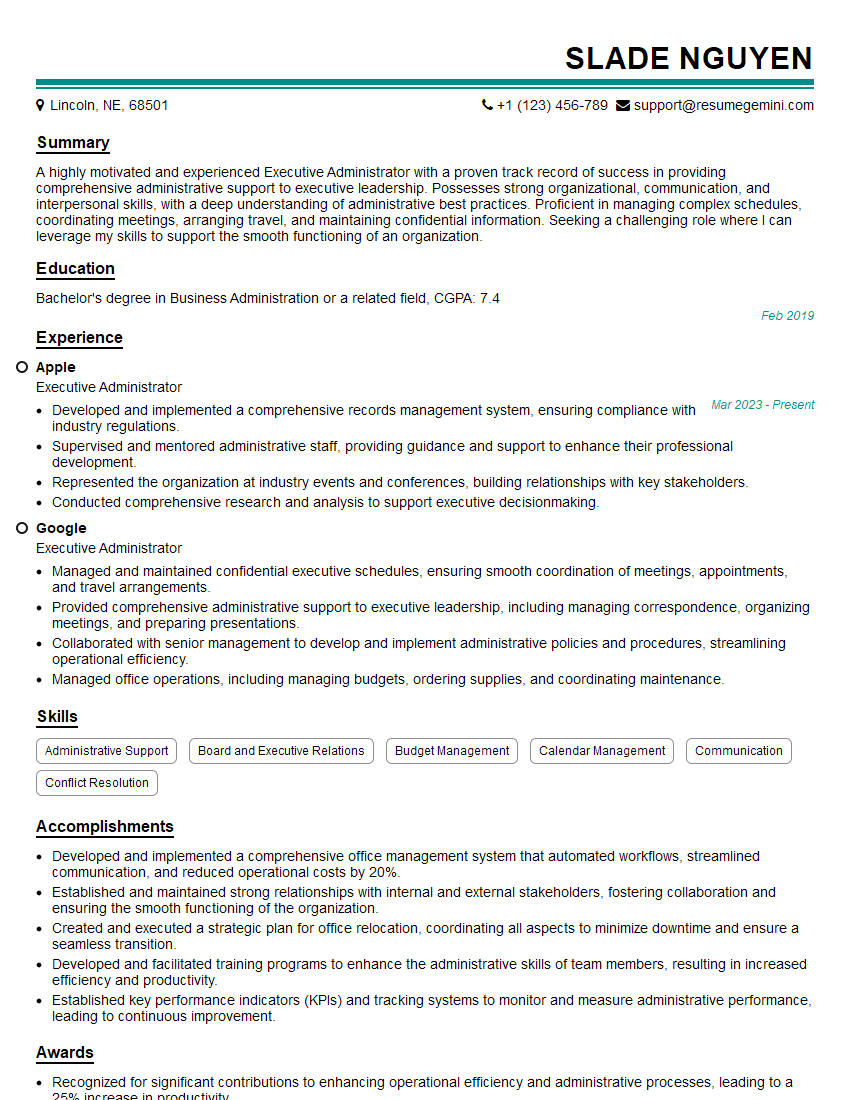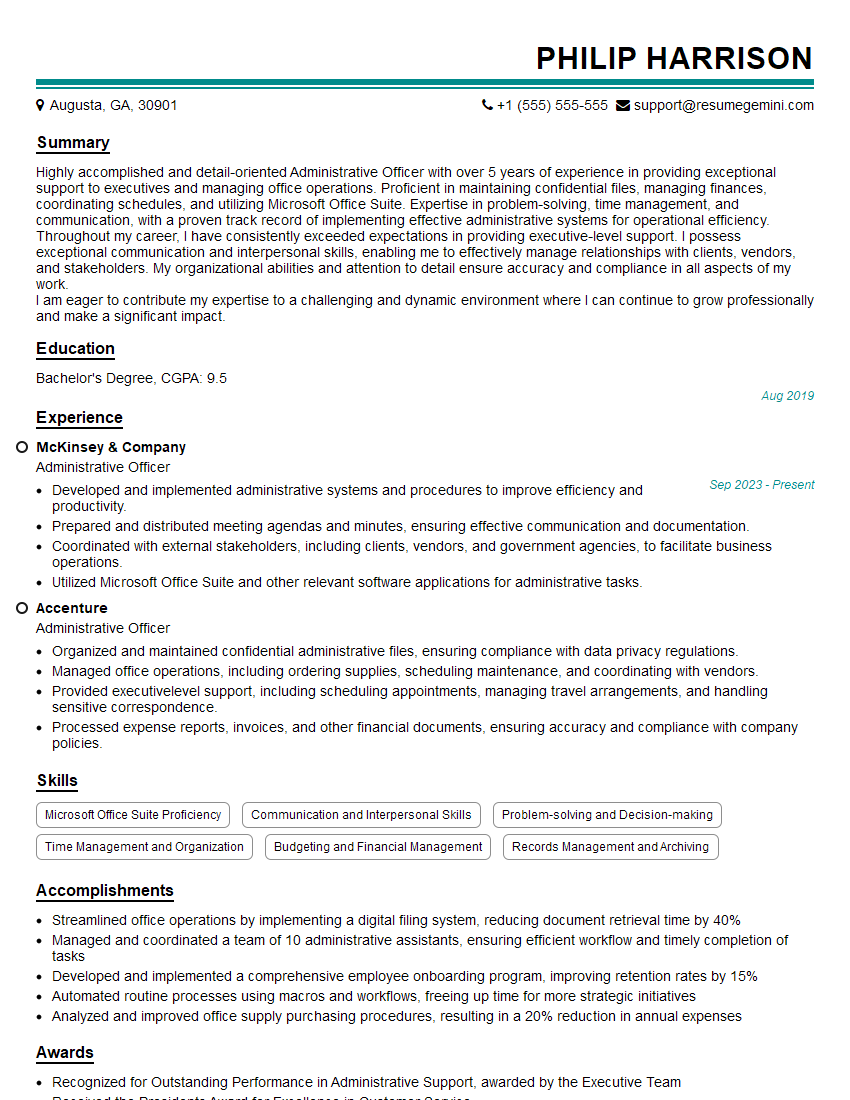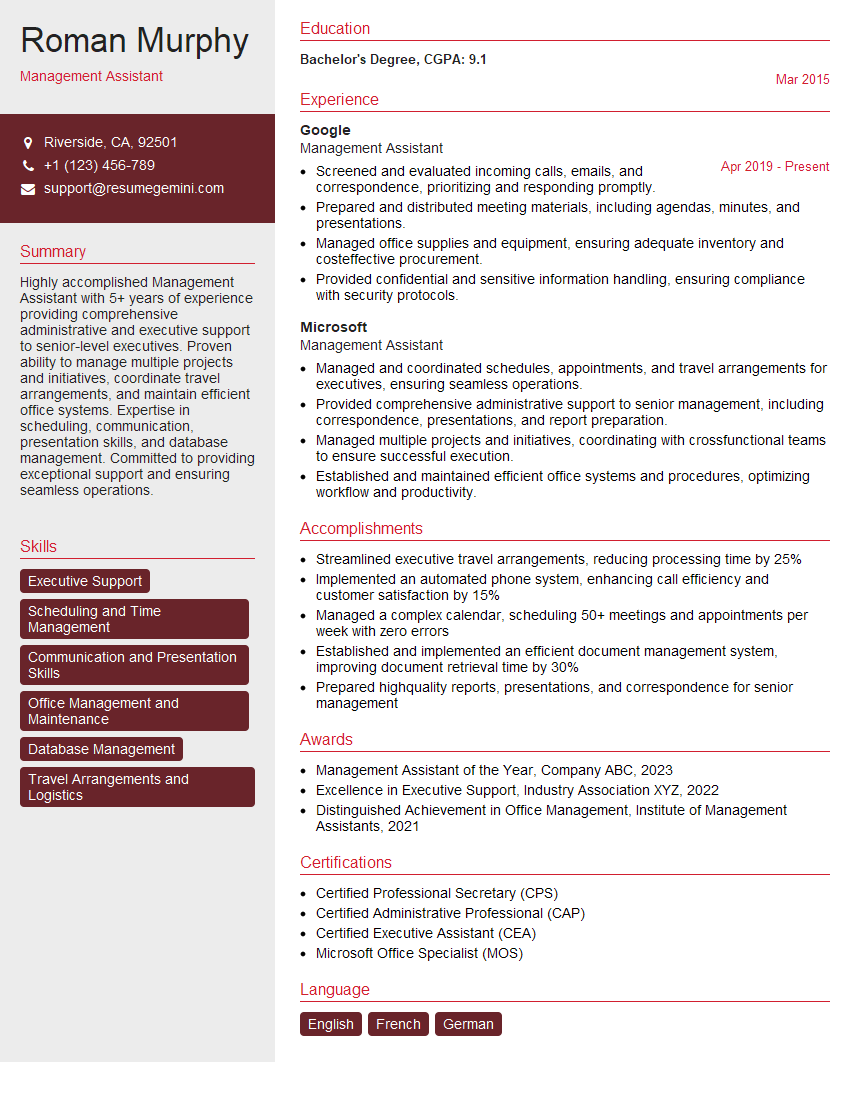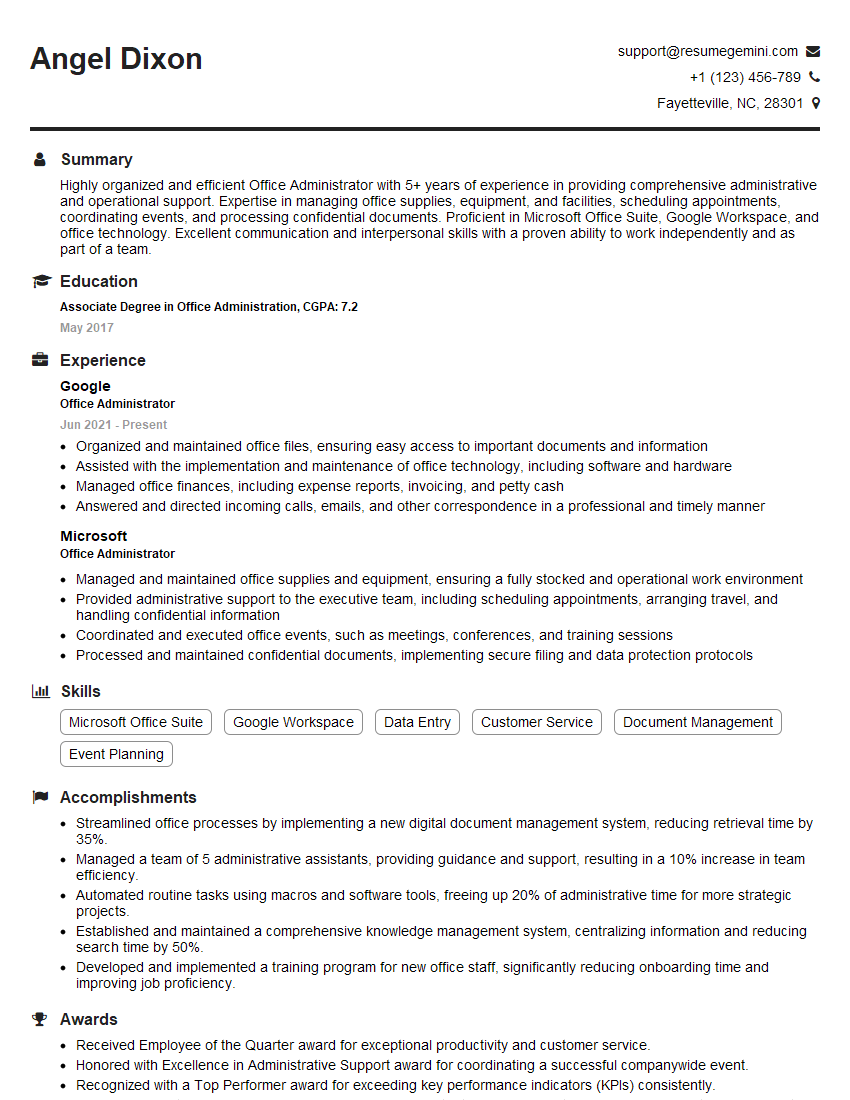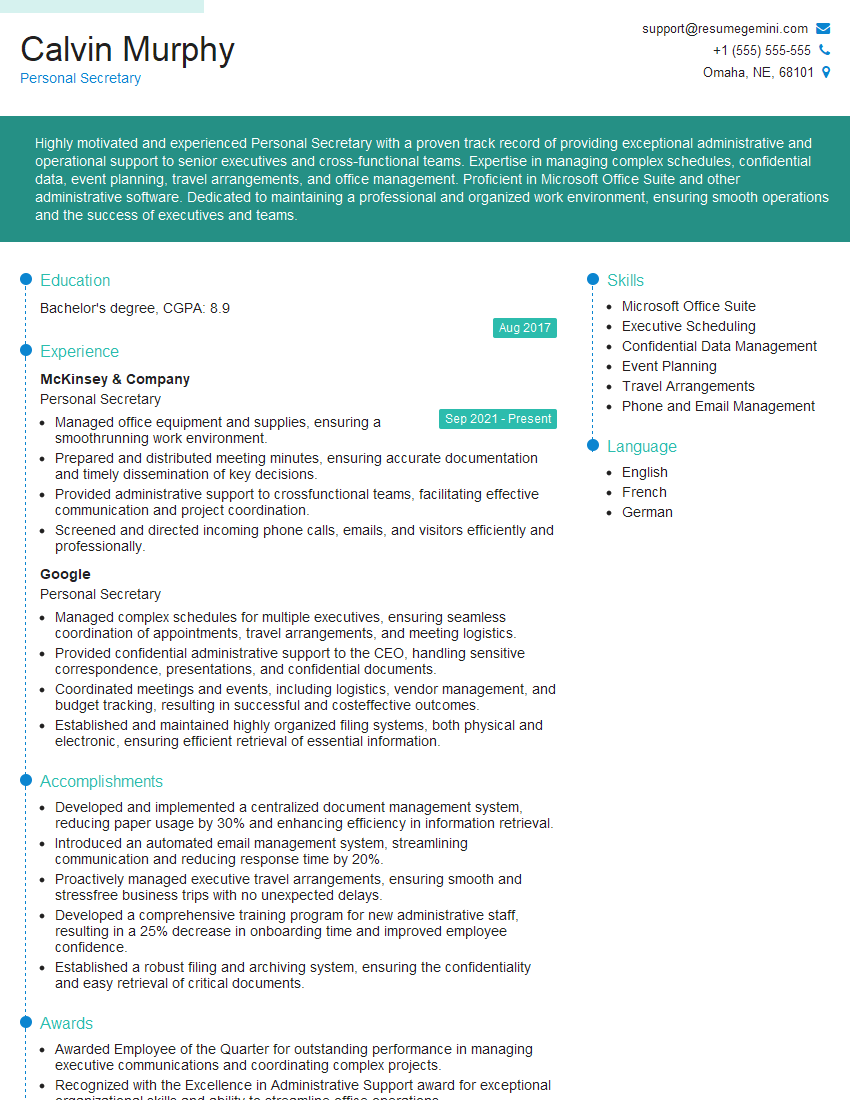Unlock your full potential by mastering the most common Diary Management interview questions. This blog offers a deep dive into the critical topics, ensuring you’re not only prepared to answer but to excel. With these insights, you’ll approach your interview with clarity and confidence.
Questions Asked in Diary Management Interview
Q 1. What software are you proficient in for diary management?
My proficiency in diary management software spans a range of tools, from widely used applications like Outlook Calendar and Google Calendar to more specialized solutions such as Calendly and Acuity Scheduling. I’m adept at leveraging the features of each platform to optimize scheduling efficiency. For example, I utilize Outlook’s recurring appointment functionality for routine meetings and Google Calendar’s sharing capabilities for collaborative scheduling. With Calendly, I streamline appointment booking for clients, and Acuity Scheduling allows me to manage client intake and payment processing effectively. My choice of software depends on the specific needs of the project and the client’s preferences.
Q 2. How do you prioritize conflicting appointments?
Prioritizing conflicting appointments requires a methodical approach. I start by assessing the urgency and importance of each appointment using a matrix, often visualized mentally. Appointments with hard deadlines, high-impact consequences, or involving crucial stakeholders take precedence. For instance, a critical client meeting would always supersede a less critical internal brainstorming session. Where possible, I attempt to reschedule less urgent appointments or seek compromises, such as shortening the duration of one meeting to accommodate the other. Time blocking and buffer periods in my calendar also prevent such conflicts from arising frequently. Imagine it like a traffic controller managing lanes – I reroute or optimize to ensure smooth flow and minimal delays.
Q 3. Describe your experience managing multiple calendars.
Managing multiple calendars is a regular part of my workflow. I often handle personal commitments alongside multiple professional calendars – perhaps a client’s calendar, a team’s shared calendar, and my own. I utilize color-coding to differentiate between calendars within the same platform. For example, using distinct colors for client meetings versus internal projects allows for quick visual identification. I also frequently utilize calendar syncing to ensure all calendars are synchronized and avoid double-booking or missed appointments. This requires a high degree of organizational skill and attention to detail, which I have honed over years of experience.
Q 4. How do you handle last-minute schedule changes?
Last-minute schedule changes are handled with a combination of flexibility and proactive communication. Upon receiving a change request, I immediately assess its impact on the existing schedule. If the change is minor, such as a slight time adjustment, I immediately update the affected calendars and notify relevant parties. However, for significant changes that require rescheduling multiple appointments, I initiate a thorough review to minimize disruption. I would contact all affected individuals as swiftly as possible to propose alternative times that work for everyone, emphasizing the importance of clear and prompt communication in these scenarios. Think of it like adjusting a flight schedule – swift and clear communication minimizes passenger inconvenience.
Q 5. What strategies do you use to proactively manage diaries?
Proactive diary management involves a multi-faceted approach: I regularly review my calendars to identify potential conflicts or gaps. This might include checking for upcoming deadlines and allocating sufficient time to prepare. Setting reminders and employing automated features like email notifications reduces the risk of missed appointments or deadlines. Regularly clearing out outdated or irrelevant entries keeps the calendar clutter-free and improves its usability. I also allocate specific time blocks for focused work and buffer periods for unexpected events. It’s like preventative maintenance for a machine – regular checkups prevent breakdowns.
Q 6. How do you ensure all appointments are accurately recorded?
Ensuring accurate appointment recording involves a meticulous approach: I always confirm all details – time, date, location, attendees, and the purpose of the meeting – before entering them into the calendar. I use detailed descriptions for each entry that capture relevant context. I also employ a double-checking system, reviewing the calendar entry after creation to ensure accuracy and completeness. Utilizing digital tools with integrated reminder functions further ensures no appointments are missed or forgotten. This is crucial for maintaining professional credibility and minimizing the risks of misunderstandings.
Q 7. Explain your method for managing travel arrangements.
Managing travel arrangements involves integrating travel details into my diary. I typically book flights and accommodation in advance and add reminders for check-in deadlines and departure times. I use dedicated travel apps for easier access to booking information and itineraries. I carefully account for travel time when scheduling appointments to avoid delays and ensure punctuality. Importantly, all travel-related details are clearly recorded in my calendar to serve as a comprehensive reference point throughout the entire journey. This keeps everything centralized and avoids unnecessary stress. Think of it like a well-planned expedition – every detail is meticulously managed to ensure a smooth voyage.
Q 8. How do you maintain confidentiality in diary management?
Confidentiality is paramount in diary management. It’s not just about protecting sensitive information; it’s about building trust and maintaining professional integrity. My approach involves several key strategies:
- Strict Access Control: I ensure only authorized individuals have access to the diary system, utilizing password protection and role-based access controls. This means different levels of access are granted based on job responsibilities. For example, an executive assistant might have full access, while a team member might only see their own appointments.
- Secure Data Storage: All diary data is stored securely, adhering to company policies and relevant data protection regulations (like GDPR or CCPA). This could involve using encrypted cloud storage or secure on-premises servers.
- Data Minimization: I only record necessary information in the diary. Sensitive details are avoided unless absolutely essential for scheduling purposes.
- Confidentiality Agreements: Where appropriate, I ensure all individuals involved understand and sign confidentiality agreements to reinforce the importance of data protection.
- Regular Audits: I perform regular audits of access logs to detect and address any unauthorized access attempts.
Think of it like a highly secure vault: only authorized personnel with the correct keys can access the contents. This approach consistently protects the sensitive information entrusted to me.
Q 9. How do you handle requests outside of working hours?
Handling requests outside of working hours requires a balanced approach that prioritizes both the needs of the individual and my own well-being. I usually set clear boundaries. If an urgent matter arises, I might respond promptly, but for non-urgent requests, I’ll typically acknowledge receipt and set expectations for a response during regular working hours. This might involve setting up an auto-reply indicating when to expect a response.
For example, if I receive an email at 10 pm requesting a meeting schedule, I’ll likely respond with something like: “Thank you for your email. I’ll review your request and respond during regular business hours tomorrow.” This sets a clear boundary while still maintaining professionalism and responsiveness.
Utilizing tools like out-of-office messages can also help manage expectations and prevent undue stress. The key is clear communication and establishing reasonable response times.
Q 10. Describe a time you had to resolve a scheduling conflict.
I once had to resolve a conflict between two senior executives who both needed to meet with a key client on the same day. Both meetings were crucial.
My approach involved several steps:
- Gather Information: I carefully reviewed the details of both meetings, including their objectives, duration, and client’s availability.
- Explore Alternatives: I explored potential solutions, such as rescheduling one of the meetings, shortening meeting durations, or finding a time that accommodated both executives and the client. I also considered whether a conference call might be a suitable alternative for one of the meetings.
- Consult with Executives: I spoke with each executive individually to understand their priorities and constraints. This helped me understand the urgency and importance of each meeting.
- Propose a Solution: I proposed a solution that minimized disruption while respecting the importance of both meetings. In this case, we managed to successfully reschedule one meeting, minimizing overlap.
- Confirm and Communicate: Finally, I confirmed the revised schedule with all parties involved and communicated the changes clearly and promptly. This included sending updated calendar invites to all attendees.
Successfully resolving this conflict showcased my ability to think critically, prioritize effectively, and communicate clearly under pressure. The key was proactive communication and a focus on finding a solution that worked for everyone involved.
Q 11. What is your experience with international time zones?
Experience with international time zones is essential for effective diary management, especially in today’s globally interconnected world. I’m proficient in using time zone converters and calendar applications that automatically adjust for different time zones. I also understand the importance of considering time differences when scheduling meetings and ensuring optimal communication.
For instance, I use tools that allow me to easily convert times between different time zones and ensure that meeting invitations reflect the correct times for each attendee regardless of their location. I also account for factors like potential cultural differences in work schedules and communication styles when scheduling international meetings.
My experience includes successfully scheduling and coordinating meetings between teams located in various regions, such as the US, UK, Asia and Australia. This involves careful consideration of working hours in each region to avoid scheduling conflicts and ensure optimal meeting participation.
Q 12. How do you deal with difficult or demanding individuals?
Dealing with difficult or demanding individuals requires patience, diplomacy, and clear communication. My strategy focuses on empathy, clear boundaries, and professionalism.
- Active Listening: I carefully listen to their concerns to understand their perspective.
- Empathetic Response: I acknowledge their feelings, even if I don’t agree with their approach. This helps de-escalate the situation.
- Clear Communication: I explain the constraints and policies clearly, ensuring they understand the reasoning behind my decisions.
- Finding Common Ground: I try to find common ground and work towards a mutually acceptable solution, focusing on collaboration rather than confrontation.
- Escalation Protocol: If necessary, I involve my supervisor to support the resolution process.
Remember, maintaining a calm and professional demeanor, even when faced with challenging personalities, is crucial for maintaining effective working relationships. I see each interaction as an opportunity to build trust and achieve a positive outcome, even in difficult circumstances.
Q 13. How do you ensure the diary is always up-to-date and accurate?
Ensuring the diary is always up-to-date and accurate is a core responsibility. My approach relies on a combination of diligent practices and technological tools:
- Real-time Updates: I update the diary immediately whenever changes occur, whether it’s scheduling a new meeting, rescheduling an existing one, or canceling an appointment.
- Regular Verification: I regularly verify the accuracy of the diary information against other sources, such as emails and meeting confirmations. This helps identify and correct any discrepancies promptly.
- Automated Reminders: I utilize reminder systems within the diary software to alert myself and others of upcoming appointments and deadlines.
- Technology and Software: I leverage diary management software with features like automated scheduling, conflict detection and synchronization to ensure efficiency and accuracy. I am always open to learning new software features to improve my workflow.
- Double-checking: Before confirming any appointments, I double-check all details, ensuring accuracy and preventing costly errors.
Think of it like a pilot constantly monitoring their instruments – I’m constantly reviewing and verifying the information in the diary to ensure its integrity and reliability. This prevents scheduling conflicts and ensures smooth operations.
Q 14. What is your approach to managing meeting preparation?
My approach to managing meeting preparation is proactive and organized. It’s about ensuring that both I and the attendees are well-prepared, leading to more productive and efficient meetings.
- Pre-Meeting Checklist: I use a checklist to ensure I’ve completed all necessary tasks, such as sending out meeting invitations, preparing relevant documents, and confirming the location and technology requirements.
- Agenda Preparation: I develop a clear agenda and distribute it in advance to ensure that everyone knows the objectives and expected outcomes of the meeting.
- Document Preparation: I ensure all necessary documents and materials are readily available and easily accessible to all participants before the meeting begins.
- Technology Check: I confirm the functionality of technology such as video conferencing or presentation tools prior to meeting commencement.
- Post-Meeting Tasks: I schedule time after the meeting to follow up on any action items or decisions made during the meeting.
This structured approach ensures that meetings are efficient and effective, minimizing wasted time and maximizing productivity. Thorough preparation is key to a successful meeting.
Q 15. How familiar are you with different calendar systems (e.g., Outlook, Google Calendar)?
I’m highly proficient with various calendar systems, including Outlook, Google Calendar, and others like Exchange and Apple Calendar. My experience spans using them individually and integrating them for seamless data flow. For instance, I’ve successfully managed complex schedules involving multiple time zones by leveraging Google Calendar’s time zone features and Outlook’s recurring meeting functionalities. I understand the nuances of each system, such as the differences in sharing options, notification settings, and task management capabilities. This allows me to adapt quickly to different environments and optimize workflows based on the specific needs of the situation.
- Outlook: I’m adept at using its robust features like categories, flags, and rules for efficient task and appointment management.
- Google Calendar: I’m familiar with its collaborative tools, resource booking capabilities, and integration with other Google Workspace applications.
- Other Systems: My experience extends to other calendar systems, enabling me to quickly learn and adapt to any new platform.
Career Expert Tips:
- Ace those interviews! Prepare effectively by reviewing the Top 50 Most Common Interview Questions on ResumeGemini.
- Navigate your job search with confidence! Explore a wide range of Career Tips on ResumeGemini. Learn about common challenges and recommendations to overcome them.
- Craft the perfect resume! Master the Art of Resume Writing with ResumeGemini’s guide. Showcase your unique qualifications and achievements effectively.
- Don’t miss out on holiday savings! Build your dream resume with ResumeGemini’s ATS optimized templates.
Q 16. How do you handle sensitive information in a diary?
Handling sensitive information in a diary requires a multi-layered approach prioritizing confidentiality and security. This includes adhering to strict data protection policies, using strong passwords and two-factor authentication where available, and limiting access to authorized personnel only. For physical diaries, secure storage is crucial, and digital diaries should be password-protected and encrypted. I would never leave sensitive information visible on a computer screen or in an unsecured location. Think of it like handling financial documents – extreme care and discretion are paramount.
- Access Control: Implementing strict access controls through password protection and user permissions.
- Data Encryption: Employing encryption for sensitive data both in transit and at rest.
- Regular Backups: Regularly backing up data to prevent data loss.
- Compliance: Adhering to relevant data protection regulations and company policies.
Q 17. Describe your experience with booking and managing meeting rooms.
My experience with booking and managing meeting rooms encompasses both manual and automated systems. I’ve used dedicated room booking software, integrated calendar features within larger platforms, and even managed bookings through spreadsheets in smaller organizations. I understand the importance of considering factors like room capacity, equipment availability, and potential conflicts. For example, I’ve successfully managed the booking of multiple meeting rooms across different locations for a large conference, ensuring smooth coordination and avoiding clashes. My approach is always to prioritize efficiency and minimize disruptions.
- Software Proficiency: Experience with various room booking systems and their integration with calendar applications.
- Conflict Resolution: Skill in identifying and resolving scheduling conflicts efficiently.
- Resource Management: Ability to track room availability and optimize utilization.
Q 18. How do you delegate tasks related to diary management?
Delegating diary management tasks requires clear communication and a well-defined process. This involves outlining responsibilities, providing clear instructions, setting deadlines, and establishing a feedback mechanism. I prioritize clear communication and ensuring the delegate understands the context, importance, and confidentiality of the tasks. For example, I might delegate appointment scheduling to an assistant, providing them with access to my calendar and clear guidelines on acceptable appointment durations and priority levels. Regular follow-ups and a collaborative workflow are crucial for successful delegation.
- Clear Instructions: Providing comprehensive and unambiguous instructions for each task.
- Training and Support: Offering sufficient training and ongoing support to the delegate.
- Monitoring and Feedback: Regularly monitoring progress and providing constructive feedback.
Q 19. How do you track and manage expenses related to appointments?
Tracking and managing expenses related to appointments involves meticulous record-keeping and adherence to company policies. This typically involves documenting all expenses, such as travel costs, accommodation, and meeting-related materials. I utilize expense tracking software or spreadsheets to maintain organized records, ensuring all receipts are attached and expenses are categorized appropriately. Reconciling these expenses against budgets is a crucial aspect to ensure financial accountability. This process is akin to managing a personal budget – detailed records and clear categorization are key to understanding spending patterns and identifying potential areas for savings.
- Expense Tracking Software: Utilizing software for efficient expense tracking and reporting.
- Receipt Management: Maintaining organized records of all receipts and invoices.
- Budget Reconciliation: Regularly reconciling expenses against allocated budgets.
Q 20. How do you communicate schedule changes to stakeholders?
Communicating schedule changes requires a proactive and multi-faceted approach. I utilize various communication channels, selecting the most appropriate method depending on urgency and the number of stakeholders involved. For minor changes, a simple email notification may suffice. For significant changes, more formal communication, such as a meeting or a detailed announcement, is necessary. Always confirming receipt and understanding is crucial. Think of it as sending out an important announcement – you wouldn’t just post it and hope people see it; you need to ensure everyone is informed and understands the implications.
- Email Notifications: Using email for timely updates and notifications.
- Calendar Updates: Updating the shared calendar to reflect schedule changes immediately.
- Formal Announcements: Making formal announcements for significant schedule changes.
Q 21. What is your process for confirming appointments?
My appointment confirmation process depends on the importance and nature of the appointment. For routine appointments, a simple calendar invite with a clear subject line and details is sufficient. However, for critical appointments, I’ll follow up with a phone call or email confirmation within 24 hours of scheduling. This confirms the time, date, location, and any special instructions. I’ll also resend the calendar invite to ensure they have the latest version and I’ll seek confirmation of their attendance. This ensures there are no misunderstandings and the appointment is properly recorded.
- Calendar Invites: Using calendar invites for scheduling and initial confirmation.
- Follow-up Communication: Sending follow-up emails or making phone calls for critical appointments.
- Confirmation of Attendance: Confirming attendance closer to the appointment time.
Q 22. How do you maintain a professional and efficient working style?
Maintaining a professional and efficient working style in diary management hinges on organization, proactive planning, and effective communication. I believe in a meticulous approach, starting with a clear understanding of the individual’s or team’s needs. This involves a thorough initial onboarding process where I clarify preferences regarding scheduling, communication methods, and priorities.
For instance, I’d establish preferred meeting durations, clarify how urgent requests are handled, and document any recurring appointments. I then utilize digital tools to maximize efficiency, employing calendar software with features such as reminders, color-coding, and automated notifications. This proactive approach prevents scheduling conflicts and ensures timely reminders for all appointments.
Finally, clear and concise communication is key. I actively update stakeholders on scheduling changes and ensure that all relevant parties are informed promptly. This open communication builds trust and allows for collaborative scheduling adjustments when needed. This systematic and communicative approach allows for streamlined scheduling and a stress-free workflow for everyone involved.
Q 23. How do you handle multiple requests simultaneously?
Handling multiple requests simultaneously requires a structured approach and effective time management. I employ a prioritization matrix to categorize requests based on urgency and importance. This allows me to focus on time-sensitive matters first while ensuring that all tasks are addressed efficiently.
For example, using a simple system like assigning priorities (High, Medium, Low) and deadlines helps in creating a clear roadmap. I might utilize tools such as Kanban boards or project management software to visually manage the workflow. Furthermore, I regularly check for any overlapping appointments or potential conflicts and proactively address these, communicating any potential delays to the relevant parties. Open communication is paramount in managing expectations effectively.
In short, a combination of prioritization, robust tools, and transparent communication ensures that multiple requests are handled efficiently and systematically, preventing delays and maintaining clarity throughout the process.
Q 24. How would you deal with a double-booked appointment?
A double-booked appointment is a serious scheduling error requiring immediate action. My first step is to identify the conflicting appointments, noting their times, participants, and importance. I then promptly contact both parties involved, explaining the situation and offering apologies for the oversight.
Next, I present several solutions, prioritizing the most important appointment based on pre-determined criteria discussed during the onboarding. This could involve rescheduling one of the appointments to a mutually agreeable time, finding an alternative meeting location, or suggesting a different communication method (e.g., a conference call instead of an in-person meeting). I would also document the resolution clearly, including the amended schedule and a note detailing the steps taken to rectify the error.
Finally, I would analyze how the double-booking occurred to identify weaknesses in my existing system. This might lead to improvements in my scheduling processes, such as implementing stricter checks and balances or adopting more robust calendar software features to prevent future occurrences.
Q 25. What measures do you take to prevent scheduling errors?
Preventing scheduling errors requires a multi-pronged approach incorporating technological solutions and meticulous procedural practices. I use calendar software with robust features such as automated notifications, reminders, and the ability to set up recurring appointments. This minimizes the risk of human error related to forgetting or overlooking scheduled events. I also regularly back up my calendar data to prevent data loss.
Beyond technology, I follow a strict procedure that involves double-checking all scheduled appointments before confirming them. This includes verifying the time, date, location, and participant details. I maintain a detailed log of all appointments, recording any relevant notes or specific instructions. This logging provides a clear audit trail to trace any issues back to their source. Furthermore, I maintain open lines of communication with the stakeholders, inviting feedback on the scheduling process to identify and rectify any potential challenges proactively. Regular system review and improvements are essential for maintaining scheduling accuracy.
Q 26. How do you adapt to changing priorities and deadlines?
Adapting to changing priorities and deadlines is crucial in diary management. I employ a flexible and agile approach, utilizing project management principles to manage my workflow efficiently. When priorities shift, I immediately review the existing schedule and assess the impact of the changes. This involves re-prioritizing tasks and reallocating time accordingly. I use color-coding or tags on my calendar to easily identify urgent tasks and deadlines.
For example, if a high-priority meeting is unexpectedly added, I might need to postpone or reschedule less critical appointments. I communicate these changes proactively to all stakeholders, ensuring transparency and maintaining a collaborative approach. This ensures that everyone is informed and aware of the adjustments. Regular review of the calendar and open communication are key components of successfully adapting to dynamic environments, minimizing disruptions, and maintaining workflow integrity.
Q 27. Describe your experience using CRM software integrated with scheduling.
I have extensive experience using CRM (Customer Relationship Management) software integrated with scheduling systems. In my previous role, I utilized Salesforce, which seamlessly integrated with Google Calendar. This allowed for centralized management of client information and appointments. The integration was crucial for maintaining accurate contact details, appointment history, and associated notes in a single platform.
For example, when scheduling a meeting with a client, I could easily access their contact information directly from the CRM, ensuring accuracy and minimizing data entry duplication. The system also automatically updated the client’s record with details of the meeting scheduled, providing a comprehensive overview of client interaction. This integration streamlined the entire process, eliminating manual data transfer and improving overall efficiency. I also leveraged the reporting functionalities within the CRM to track meeting frequency, identify trends, and generate reports for business analysis. The effectiveness of this integrated approach contributed significantly to improving both operational efficiency and client relationship management.
Q 28. How do you ensure smooth handover of diary management responsibilities?
Ensuring a smooth handover of diary management responsibilities requires thorough documentation and clear communication. My approach involves a comprehensive handover process, starting with the creation of detailed documentation that includes:
- A complete calendar overview with all scheduled appointments, recurring events, and contact details.
- Standard operating procedures detailing workflows and processes for scheduling, handling requests, and managing conflicts.
- A list of key contacts, including contact information and their communication preferences.
- Instructions for accessing and managing relevant software and digital tools.
This detailed documentation provides the new diary manager with all the necessary information to seamlessly take over. I would then schedule several handover meetings with the new individual, going through the documentation and answering any questions. This includes training them on using the relevant software and systems. Finally, I’d offer ongoing support during a transition period to address any immediate concerns or challenges. This comprehensive approach ensures a smooth transfer of responsibilities, minimizing disruptions and preserving workflow efficiency.
Key Topics to Learn for Diary Management Interview
- Scheduling and Appointment Management: Understanding different scheduling methods (e.g., time blocking, buffer times), optimizing appointment scheduling for efficiency, and handling scheduling conflicts.
- Calendar Systems & Software Proficiency: Demonstrate familiarity with various calendar applications (Outlook, Google Calendar, etc.), including features like recurring appointments, reminders, and resource allocation. Be prepared to discuss your experience with different systems and their functionalities.
- Prioritization and Time Management: Explain your approach to prioritizing appointments based on urgency and importance, and how you manage competing demands on your time and the executive’s schedule.
- Communication & Collaboration: Discuss effective communication strategies with clients, colleagues, and executives regarding scheduling changes, confirmations, and potential conflicts. Highlight your experience working collaboratively to manage shared calendars.
- Data Entry & Accuracy: Emphasize the importance of accurate data entry and the potential impact of errors. Describe your approach to double-checking information and maintaining data integrity.
- Travel Arrangements & Itinerary Management: If applicable to the role, discuss your experience in arranging travel plans, including booking flights, accommodation, and transportation, and managing travel itineraries.
- Problem-Solving & Adaptability: Be prepared to discuss how you handle unexpected changes or conflicts in scheduling, and how you adapt to evolving priorities and deadlines. Showcase your ability to find creative solutions to scheduling challenges.
- Confidentiality & Discretion: Highlight your understanding of the importance of maintaining confidentiality and handling sensitive information with discretion.
Next Steps
Mastering diary management is crucial for career advancement, demonstrating organizational skills and efficiency vital across many professions. A strong grasp of these concepts significantly improves your candidacy and opens doors to exciting opportunities. To maximize your job prospects, focus on creating an ATS-friendly resume that showcases your skills effectively. We highly recommend using ResumeGemini to build a professional and impactful resume. ResumeGemini offers valuable resources and examples tailored to Diary Management roles to help you present your qualifications in the best possible light. Examples of resumes tailored to Diary Management are available to help you get started.
Explore more articles
Users Rating of Our Blogs
Share Your Experience
We value your feedback! Please rate our content and share your thoughts (optional).
What Readers Say About Our Blog
Hi, I’m Jay, we have a few potential clients that are interested in your services, thought you might be a good fit. I’d love to talk about the details, when do you have time to talk?
Best,
Jay
Founder | CEO
